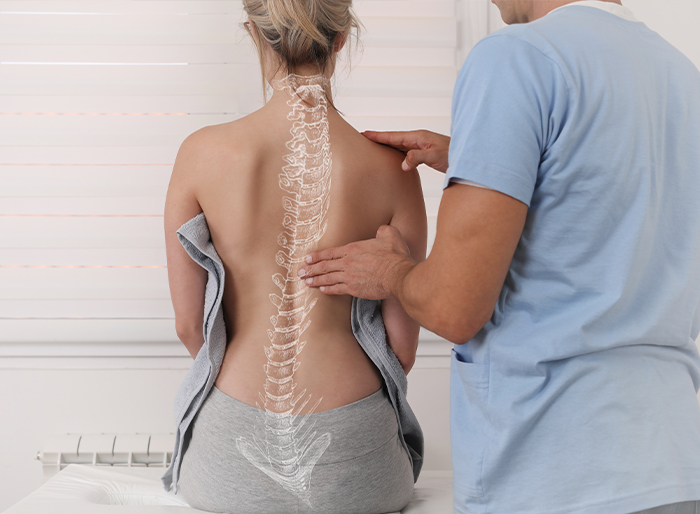Spinal decompression is an effective way to treat back pain from back conditions. Unlike invasive surgeries, spinal decompression treatment is incredibly easy and noninvasive. Using a spinal decompression table, like the DRX spinal decompression table at Roach Family Wellness, on a regular basis can help cure your spinal condition over time. You can trust that the DRX treatment works. Dr. Roach developed a protocol that helps both cervical (neck) and lumbar (back) disc injuries after he avoided surgery for his own pain by going through the process himself.
Schedule Your DRX9000 Nonsurgical Eval Today!Best Candidates for Spinal Decompression Treatment
1. Herniated Disc & Sciatica Patients
If you suffer from a herniated disc or sciatica from a herniated disc, spinal decompression is one of the most effective, noninvasive treatments out there. By using a spinal decompression table, a herniated disc patient can take the pressure off of the disc and promote healing. After consistent spinal decompression treatments, around 25 to 40, many herniated disc and sciatica sufferers report being completely cured of their pain.
2. Degenerative Disc Patients
A patient with degenerative disc disease is another candidate for spinal decompression treatment. Degenerative disc disease is caused by a few different factors including an injury causing a herniated disc and obesity. The padding between the vertebrae will slowly break down making the spine less stable and putting pressure on the surrounding nerves. Using spinal decompression treatment can reverse the effects of degenerative disc disease by taking pressure off the spine and allowing the vertebrae padding to heal.
3. Facet Syndrome Patients
Facet syndrome is a spinal syndrome that causes pain at the joint of two vertebrae. It typically is caused from general wear and tear from aging. A patient suffering from facet syndrome is a candidate for spinal decompression treatment. Using spinal decompression, you can correct the deterioration of the spine caused by facet syndrome, as well as cure the painful side effects of the wear and tear.
4. Failed Spinal Surgery
If you’ve experienced a spinal surgery that failed at healing your pain or is causing chronic pain, you are a candidate for spinal decompression treatment as well. Using spinal decompression treatments consistently you can correct the chronic pain. Patients that use 25 to 40 spinal decompression treatments have reported their pain being completely under control.
5. Failure to Improve After 2 Nonoperative Treatments
Another candidate for spinal decompression treatment is a patient who has tried other nonoperative treatments with no luck. For example, if you’ve used medical massage, chiropractic care, or physical therapy and are still experiencing chronic pain from a spinal condition, spinal decompression could do the trick at treating your pain.
Nonsurgical Spinal Decompression Using the DRX 9000
Spinal decompression has been around and used worldwide to treat disc problems for over 30 years. Disc problems happen from injury, usually trauma, repetitive stress, or even carrying around too much weight on the midsection. Lack of spinal maintenance, such as regular chiropractic adjustments, stretches, and exercise, can also cause disc problems.
The disc is the shock absorber in between the bones. When it is thick, healthy, and full of fluid, everything works great. If it gets injured or compressed, the fluid leaks out, which decreases the distance between the bones. This results in pressure put on the nerves and spinal cord, and wreaks havoc.
Most people with disc injuries experience radiating pain and numbness down the arms or legs; weakness of the muscles in the arms and legs; sharp shooting pains; feelings of getting “stuck” in a position; and paralyzing pain and muscle spasms. Others experience constant aching and stiffness that never resolves and can manifest side effects such as slow movements, staying bent over or leaning off to the side in certain positions, and using a walking device.
Most people with disc injuries have tried many solutions, such as medications, injections, physical therapy, chiropractic, massage, acupuncture, radio frequency ablations to the nerve, and even surgical interventions. Sadly, most of these only ease the discomforts associated with discogenic pain. To treat the cause, you need to take it a step further.
Most Common Pain Treated by Spinal Decompression
- Headaches
- Pain down the arms
- Wrist pain
- Leg pain
- Sciatica
- Knee pain
- Foot pain
- Radiating pain down the legs
- Radiating pain down the arms
- Numbness in the fingers or toes
- Weakness of the muscles in your arms and legs
- Pain into the shoulder
